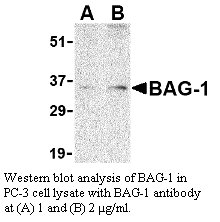Anti-Human BAG-1 (NT)
Data
- -
- -
Antibody DetailsProduct DetailsReactive Species Human Host Species Rabbit Immunogen PN:B467 Product Concentration 0.5 mg/ml Formulation This polyclonal antibody is formulated in phosphate buffered saline (PBS) pH 7.4 containing 0.02% sodium azide as a preservative. Storage and Handling This polyclonal antibody is stable for at least one week when stored at 2-8°C. For long term storage, aliquot in working volumes without diluting and store at –20°C in a manual defrost freezer. Avoid Repeated Freeze Thaw Cycles. Country of Origin USA Shipping Next Day Ambient RRIDAB_2828200 Each investigator should determine their own optimal working dilution for specific applications. See directions on lot specific datasheets, as information may periodically change. DescriptionDescriptionSpecificity Rabbit Anti-Human BAG-1 recognizes an epitope near the N-terminus of human and mouse BAG-1. This polyclonal antibody was purified using affinity chromatography. Background Bcl-2-associated athanogene 1 (BAG-1) was first identified as an anti-apoptotic bcl-2-binding protein. Later it was found to bind the molecular chaperones Hsp70 and Hsc70 through its carboxy-terminal sequence (termed the Bag domain), resulting in the inhibition of the refolding activity of these chaperones. It is thought that by binding and inhibiting these molecular chaperones, BAG-1is able to modulate the expression level of proteins requiring chaperones to fold correctly. One such group of proteins that are affected is glucocorticoid receptors. Other reports have suggested that the level of BAG-1 expression correlates with the aggressiveness of various cancers. Multiple isoforms of BAG-1 are known to exist. References & Citations1. Takayama, S. et al. (1995) Cell 80:279-84. 2. Nollen, EAA. et al. (2000) Mol. Cell. Biol. 20:1083-8. 3. Cato, ACB. and Mink, S. (2001) J Steroid Biochem Mol Biol. 78(5):379-88. 4. Kajewska, M. et al. (2006) Prostate 66:801-10. Technical ProtocolsCertificate of Analysis |
Related Products
- -
- -
Prod No. | Description |
|---|---|
B441 | |
B442 | |
B466 | |
B467 | |
B593 |



